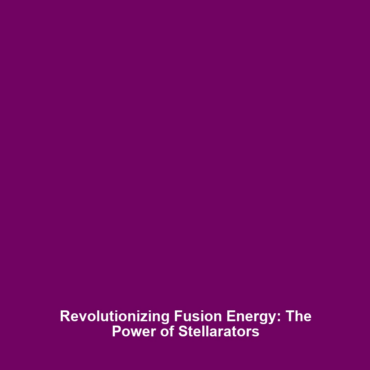Stellarators: Pioneering Fusion Energy Technology
Introduction
Stellarators are a groundbreaking type of fusion reactor designed to replicate the processes that power the stars. As the world seeks sustainable energy solutions, understanding the significance of Stellarators within the broader context of Fusion Energy is critical. These innovative devices offer a potentially viable path toward clean and abundant energy production, representing a crucial advancement in the quest for energy independence and environmental sustainability.
Key Concepts
Understanding Stellarators
The Stellarator operates on the principle of magnetic confinement, wherein plasma—the state of matter necessary for fusion—is contained and controlled using magnetic fields. This unique design employs twisted magnetic coils to maintain equilibrium, preventing plasma instabilities that can hinder fusion reactions. As a result, Stellarators differentiate themselves from traditional tokamaks, each contributing uniquely to the field of Fusion Energy.
Fusion Energy Mechanisms
Fusion energy is generated when light atomic nuclei combine to form heavier nuclei, releasing vast amounts of energy in the process. Stellarators aim to achieve this through:
- Magnetic confinement techniques
- Advanced plasma physics
- Innovative engineering and design to sustain high-temperature plasmas
Applications and Real-World Uses
The applications of Stellarators in Fusion Energy are vast, poised to transform how we approach energy production. Some notable real-world uses include:
- Research facilities like the Wendelstein 7-X in Germany, which aims to demonstrate the viability of Stellarator technology for sustained fusion reactions.
- Potential integration into national power grids as a clean energy source, should ongoing experiments prove successful.
These examples showcase how Stellarators are utilized in advancing the field of Fusion Energy, aiming for a sustainable future.
Current Challenges
Despite the promise held by Stellarators, there are several challenges that must be addressed, including:
- High construction and operational costs associated with complex engineering.
- Significant technical hurdles in sustaining stable plasma confinement.
- Long development timelines that may delay realization of widespread applications.
These challenges illustrate the hurdles faced in the study and implementation of Stellarator technology.
Future Research and Innovations
Research into Stellarators continues to advance, focusing on next-generation technologies that promise to enhance their efficiency and effectiveness in Fusion Energy. Key areas of innovation involve:
- Integration of artificial intelligence for real-time plasma control.
- Enhanced materials capable of withstanding extreme conditions inside fusion reactors.
- Collaboration with international research institutions to combine efforts and share technological breakthroughs.
Such innovations signal a bright future for Stellarators and their role in global energy solutions.
Conclusion
In summary, Stellarators represent a pioneering approach in fusion energy technology, bearing the potential to significantly influence the sustainable energy landscape. As we continue to explore their implications and applications, it is crucial to stay informed about advancements in this field. For further reading on related topics, visit our other pages on Fusion Energy and Plasma Physics.

